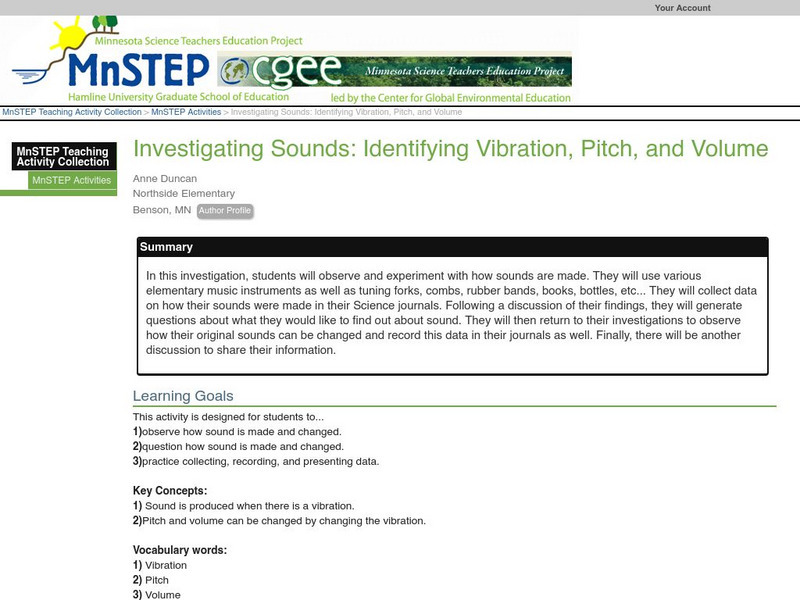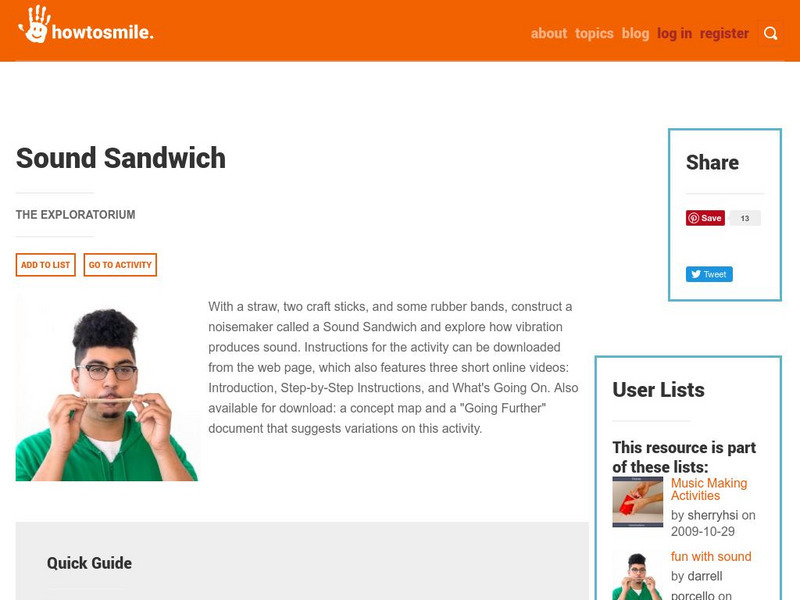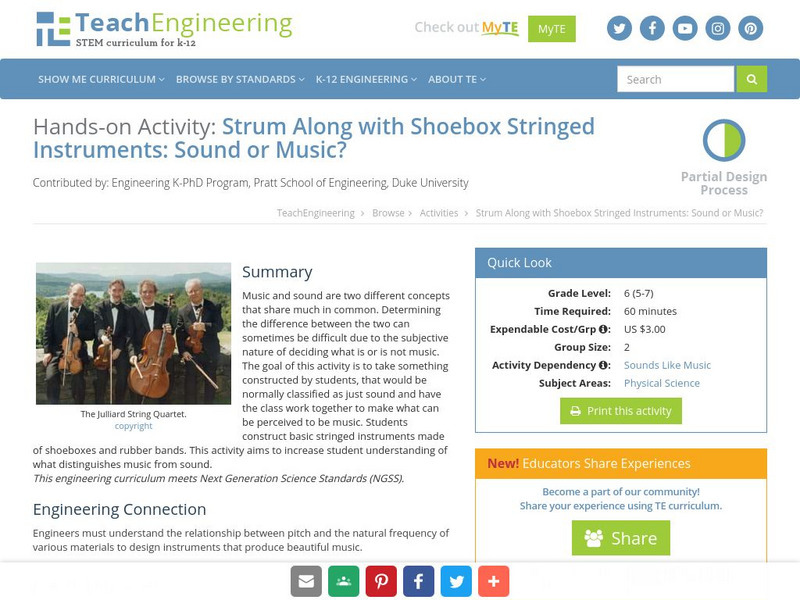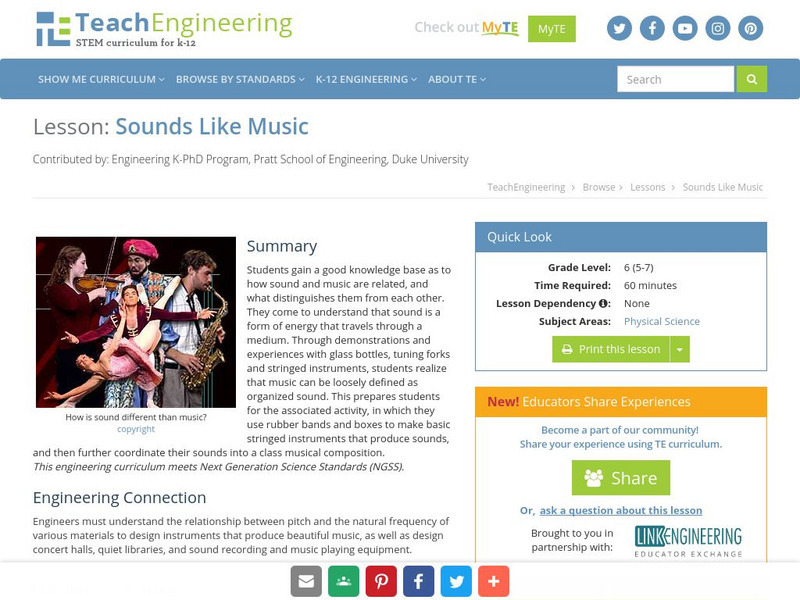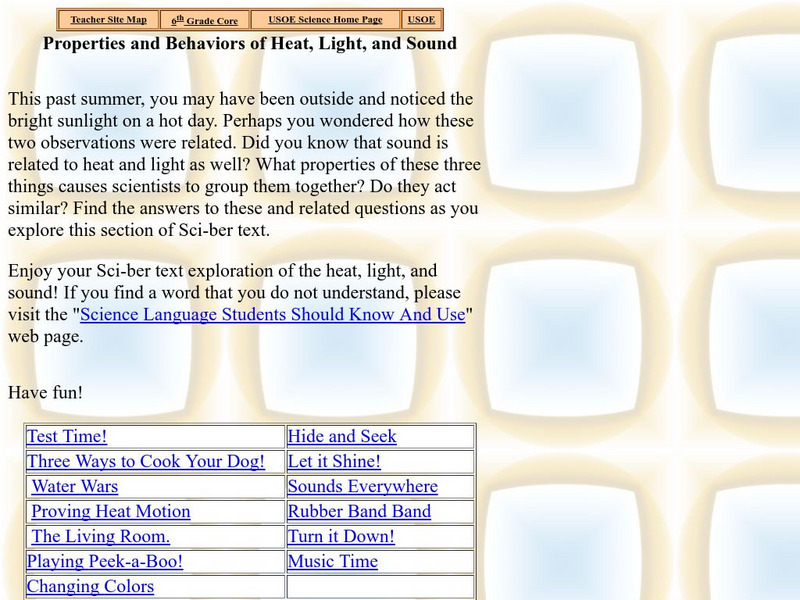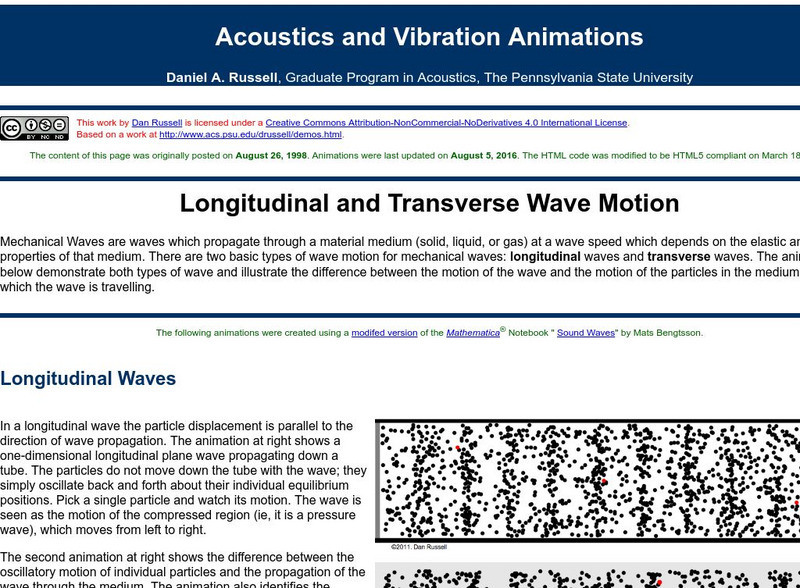Science Buddies
Science Buddies: Measuring Vibrational Frequency With Light
Strike a key on the piano, and you hear the string vibrating. Just about any object vibrates when it's knocked, but how much and how fast? This project helps you find out. You'll build a simple light-sensing circuit for measuring the...
Science Buddies
Science Buddies: Singing Wine Glasses
Making a glass sing is not always as easy as it looks. This project explains the science behind the interesting hobby. You will be asked how the amount of fluid within a glass affects its pitch.
Science Education Resource Center at Carleton College
Serc: Physics of Sound: How Does Length Affect Pitch?
Students investigate how pitch varies with the length of instrument in this activity. Activity includes procedure and background information.
Science Education Resource Center at Carleton College
Serc: Investigating Sounds: Identifying Vibration, Pitch, and Volume
In this investigation, students will observe and experiment with how sounds are made. They will use various elementary music instruments as well as tuning forks, combs, rubber bands, books, bottles, etc. They will collect data on how...
University of New South Wales (Australia)
University of New South Wales: Introduction to Acoustics of Brass Instruments
Discover the acoustical properties of brass instruments from this well researched site provided by the University of New South Wales. Everything from lip control to bell shape is discussed as it applies to frequencies and harmonics.
University of New South Wales (Australia)
University of New South Wales: Introduction to Flute Acoustics
Explore the physics of sound production of a flute. How do things like tone holes and register holes effect the acoustics of a flute? Learn more about that and more at this well researched site.
University of New South Wales (Australia)
University of New South Wales: Introduction to Clarinet Acoustics
Learn about how the acoustics of a clarinet work by exploring this well researched site. You'll learn about the frequencies, the effects of the reed, the tone holes and more.
Museum of Science
Museum of Science and Industry: Online Science: Straw Pipe
Instructions to create a pan pipe made from straws. Also included is music to play songs using the pan pipe and a brief background about sound vibrations.
Other
How to smile.org: Sound Sandwich
Students discover how vibrations produce sound by making this sound sandwich out of everyday materials. Lesson plans include three videos that give an introduction, step-by-step demonstration, and an explanation of the science behind the...
TeachEngineering
Teach Engineering: Strum Along
Music and sound are two different concepts that share much in common. Determining the difference between the two can sometimes be difficult due to the subjective nature of deciding what is or is not music. The goal of this activity is to...
TeachEngineering
Teach Engineering: Sounds Like Music
Music can loosely be defined as organized sound. The instructional activity objectives, understanding sound is a form of energy, understanding pitch, understanding sound traveling through a medium, and being able to separate music from...
PBS
Pbs Learning Media: Kid Musician: Mexico's Guitar Town
Visit with Andres during fiesta time at Paracho Michoacan, Mexico's "guitar town". As Andres shows in this video segment from ZOOM, guitar music goes beyond simple sound vibrations. [2:55]
US Geological Survey
U.s. Geological Survey: Listening to Earthquakes
Listen to various different types of earthquakes, and compare the sounds of various earthquake events.
OpenSciEd
Open Sci Ed: Unit 8.2 Sound Waves
In this unit, 8th graders develop ideas related to how sounds are produced, how they travel through media, and how they affect objects at a distance.
Utah State Office of Education
Utah Science: Properties and Behaviors of Heat, Light and Sound
How can scientists lump heat, light and sound together when investigating properties and behaviors? This learning module will address that question through a series of activities.
Science Education Resource Center at Carleton College
Serc: Investigating Sound: Vibrations Are the Source of Sound
In this classroom activity, young scholars will discover that when objects vibrate a sound is produced. Students will first observe different sound sources such as a music box, a sucker toy that has a stick coming out of it, etc. They...
Pennsylvania State University
Wave Animations: Longitudinal and Transverse Waves
This physics tutorial features text and animations explaining the particle motion of a medium through which transverse, longitudinal, or surface waves move.
Pennsylvania State University
Applied Physics: Experimental Research on Baseball Bat Vibrations
Fun science site that explores the vibrational behavior of a baseball/softball bat. Contains links to mode splitting in wood bats, controlling vibration, measuring the vibration of a baseball/softball bat and more!
Alabama Learning Exchange
Alex: Vibrations of Sound
Lesson about sound waves of high and low sounds. Students learn through a website, activites with rope, rulers and rubber bands on cups, and with Audacity software. Lesson is written for early elementary music students but could also be...
OpenSciEd
Open Sci Ed: 8.2 Sound Waves
Eighth graders develop ideas related to how sounds are produced, how they travel through media, and how they affect objects at a distance.
OpenSciEd
Open Sci Ed: 8.3 Forces at a Distance
This unit allows students to investigate the cause of a speaker's vibration in addition to the effect.
Other
Bscs: Sound Lesson 2: More Sound Makers: Do They Vibrate?
Do sound makers always vibrate? This lesson shows that all objects that produce sound vibrate, even if we cannot see or feel the vibrations. Included are a minute-by-minute lesson plan, activities, and teacher discussion points and...
Other
Bscs: Sound Lesson 1: Sound Makers
How can you tell if something is making a sound? This lesson will show that to produce sound, an object must vibrate. Included are a minute-by-minute lesson plan, activities, and teacher discussion points and questions.
Open Ed
Open Ed Sci: 8.3 Forces at a Distance
This unit launches with a slow-motion video of a speaker as it plays music. In the previous unit, students developed a model of sound. This unit allows students to investigate the cause of a speaker's vibration in addition to the effect.





